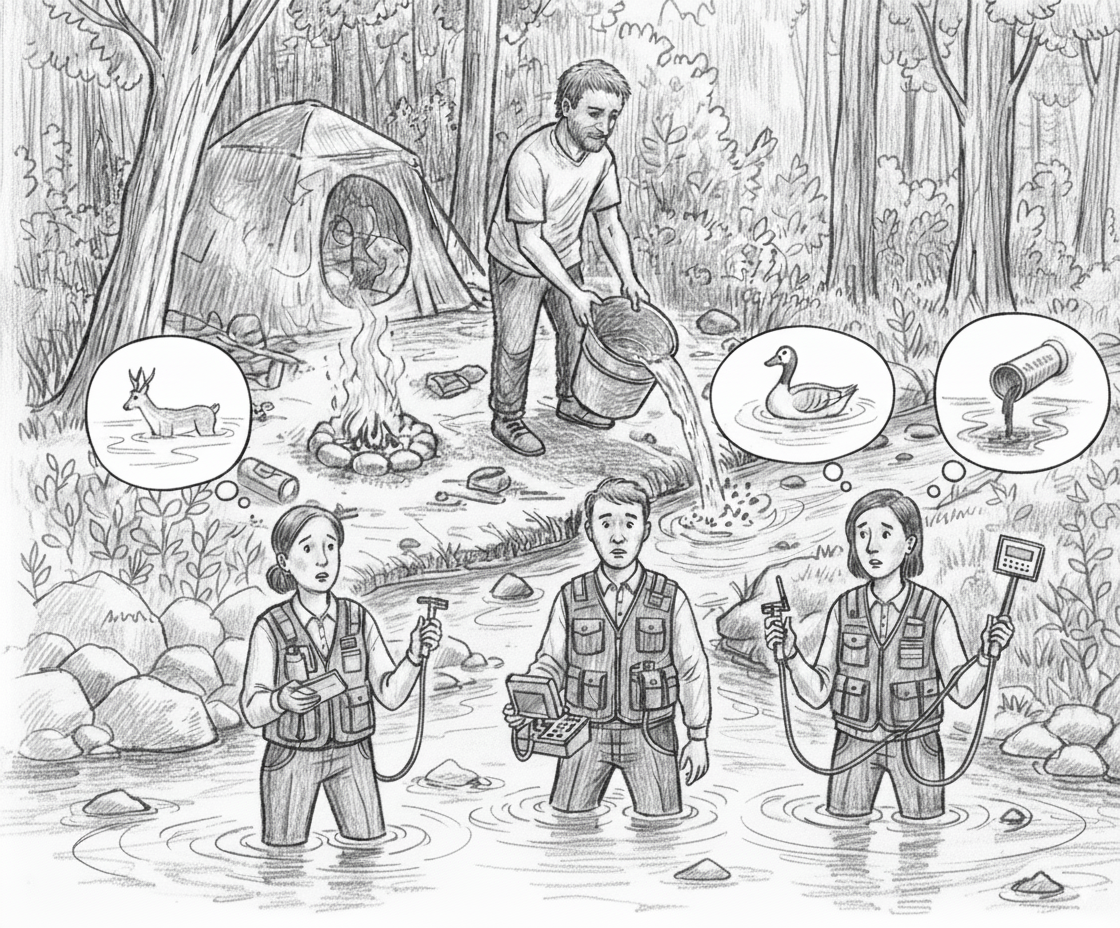The Big Chico Creek E. coli Mystery: Why the Simplest Answer Points to Human Activity

When we're trying to figure out a complex problem, there's a principle called Occam's Razor. It basically says that if you have a few different ideas that could explain something, the one that is the simplest and requires the fewest assumptions is usually the correct one. Think of it as: "the simplest explanation is usually the best."
We've been looking into the serious E. coli O157 outbreak connected to Big Chico Creek, and applying Occam's Razor, the evidence points strongly to human fecal contamination from the numerous encampments along the creek as the most likely and ongoing cause.
Here's why:
The Clear-Cut Evidence:
- The Outbreak Strain is in the Creek: Tests of water and sediment samples taken from popular spots like Sycamore Pool, the Chico Creek Nature Center (CCNC), and Five Mile Recreational Area all showed the presence of E. coli O157:H7. What's crucial is that this E. coli found in the creek is genetically almost identical to the E. coli found in people who got sick - only 0-2 differences, which is a very close match. This tells us for sure that the creek is the source of the human illnesses.
- Human Fecal Matter Detected: When scientists used special "microbial source tracking" tests, they found human fecal markers in the water samples from Sycamore Pool, CCNC, and Five Mile Rec Area. The way the samples were collected (starting downstream and moving upstream) also suggested that there was "ongoing contamination flowing in the creek" at the time. This is direct evidence that human waste is entering the creek.
- Encampments are a Persistent Reality: We all know that there are encampments all up and down Big Chico Creek and that it's difficult (or convenient depending on your perspective) for the city to move them because of the Warren Settlement. This means there's a continuous, unmanaged source of human presence along the creek. Health officials themselves recognize "encampments" as a potential source of STEC (Shiga toxin-producing E. coli). Other city documents also highlight "homeless camps" as a major source of pollution and trash in creeks. When people live outdoors without proper sanitation facilities, their waste (whether in buckets or directly) inevitably ends up in the creek.
- Sediment is a Hiding Place: E. coli O157 is known to be "very hardy in sediment". Big Chico Creek has a lot of "silt and sediment" from last year's Park Fire. This means that once the bacteria are introduced (for example, from human waste in encampments), they can survive in the creek bed for a long time, continuing to release into the water and cause problems.
Why Other Ideas Don't Quite Fit (Applying Occam's Razor):
While other sources were considered, they don't provide as simple and direct an explanation for the ongoing presence of this specific outbreak strain in the recreational areas:
- Wildlife (like geese and other birds): Avian (bird) fecal markers were found in the water and sediment. An expert from the CDC even suggested that wild birds might carry the bacteria after interacting with cattle and then bring it to the creek. However, E. coli O157 was NOT found in any goose droppings that were sent for testing. This makes it less likely that geese are the main source of the specific O157 strain causing the outbreak.
- Cattle: Ruminant (cow-like animals) fecal markers were also found. But importantly, no cow-specific fecal markers were detected. Also, the Agricultural Commissioner said that cattle grazing areas are "quite a ways upstream" and likely aren't directly contributing to the creek at the affected spots.
- Contaminated Water Fountains or Irrigation: This idea was looked into, but the Public Health Officer noted that if the source was a contaminated water system, it would only affect specific fountains. Since cases were found "all over the area" and in different parts of the creek, this isn't a simple explanation for the widespread problem. Also, irrigation water is believed (they are still confirming) to come from a well, not directly from the creek, and a "creek bypass option" to use creek water was already shut down.
The Simplest Conclusion:
When you put all the pieces together - the confirmed presence of the human-illness-causing E. coli O157 in the creek, the detection of human fecal markers, and the documented presence of unmanaged human encampments directly along the creek - the most straightforward explanation is that human waste from these encampments is a significant and continuous source of the contamination. This ongoing human input, combined with the way E. coli O157 can survive in creek sediment, creates a persistent problem for Big Chico Creek's water quality.
The simplest and most affordable solution would be to remove the encampments from the watershed, wait for spring flows to flush out contaminants, enforce a strict no-camping policy along the creek starting in spring 2026, and then retest the water quality. This approach would likely resolve the issue effectively. However, the city is currently planning to bring in additional experts ($$$) for further analysis ($$$) instead.
